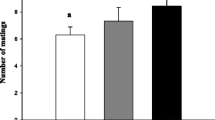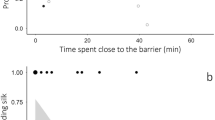Abstract
We examined the influence of female feeding regime on polyandry in the nuptially feeding nursery web spider (Pisaura mirabilis). In this species, the nuptial gift, a dead prey item wrapped in the male’s silk, is physically separate from the ejaculate. We manipulated female feeding regime (starved or fed) and the presence or absence of a gift with three successive males to test direct-benefits hypotheses (nuptial gift or sperm supply) for the expression of polyandry. The presence of a gift was necessary for copulation, as no male without a gift successfully copulated. Female mating behavior most strongly supports polyandry due to the accumulation of gifted food items (“nuptial gift” direct-benefits hypothesis). Starved females that were presented with a gift accepted significantly more gifts and inseminations than fed females. Most starved females (74%) copulated two or more times, as opposed to only 3% of the fed females. Nearly all of the females that accepted a gift subsequently copulated. The nuptial gift item seems to function as male mating effort and females appear to receive multiple matings as part of a feeding strategy.

Similar content being viewed by others
References
Ahtiainen JJ, Alatalo RV, Kortet R, Rantala MJ (2005) A trade-off between sexual signalling and immune function in a natural population of the drumming wolf spider Hygrolycosa rubrofasciata. J Evol Biol 18:985–991
Arnqvist G (1989) Multiple mating in a water strider: mutual benefits or intersexual conflict? Anim Behav 38:749–756
Arnqvist G, Nilsson T (2000) The evolution of polyandry: multiple mating and female fitness in insects. Anim Behav 60:145–164
Arnqvist G, Rowe L (2005) Sexual conflict. Princeton University Press, Princeton
Austad SN, Thornhill R (1986) Female reproductive variation in a nuptial feeding spider, Pisaura mirabilis. Bull Br Arachnol Soc 7:48–52
Bilde T, Maklakov AA, Schilling N (2007a) Inbreeding avoidance in spiders: evidence for rescue effect in fecundity of females with outbreeding opportunity. J Evol Biol 20:1237–1242
Bilde T, Tuni C, Elsayed R, Pekar S, Toft S (2007b) Nuptial gifts of male spiders: sensory exploitation of the female foraging motivation. Anim Behav 73:267–273
Birkhead TR, Møller AP (1998) Sperm competition and sexual selection. Academic, London
Boggs CL (1990) A general model of the role of male-donated nutrients in female insects’ reproduction. Am Nat 136:598–617
Bristowe WS (1958) The world of spiders. Collins, London
Bruun LE, Michaelsen KR, Sørensen A, Nielsen MH, Toft S (2004) Mating duration of Pisaura mirabilis (Araneae: Pisauridae) depends on size of the nuptial gift and not on male size. Arthr Sel 1:35–39
Buchar J, Babrakzai H, Hodek I (1989) Life-cyle and phenology of the spider Pisaura mirabilis (Araneae) in central Europe. Acta Entomol Bohem 86:414–418
Chapman T, Arnqvist G, Bangham J, Rowe L (2003) Sexual conflict. Trends Ecol Evol 18:41–47
Daly M (1978) The cost of mating. Am Nat 112:771–774
Drengsgaard IL, Toft S (1999) Sperm competition in a nuptial feeding spider, Pisaura mirabilis. Behaviour 136:877–897
Eberhard WG (1996) Female control: sexual selection by cryptic female choice. Princeton University Press, Princeton
Edvardsson M (2007) Female Callosobruchus maculates mate when they are thirsty: resource-rich ejaculates as mating effort in a beetle. Anim Behav 74:183–188
Engqvist L (2007) Females benefit from mating with different males in the scorpionfly Panorpa cognata. Behav Ecol 17:435–440
Fedorka KM, Mousseau TA (2002) Material and genetic benefits of female multiple mating and polyandry. Anim Behav 64:361–367
Garcia-Berthou E (2001) On the misuse of residuals in ecology: testing regression residuals vs. the analysis of covariance. J Anim Ecol 70:708–711
Gwynne DT (1990) Testing parental investment and the control of sexual selection in katydids: the operational sex ratio. Am Nat 136:474–484
Gwynne DT (2008) Sexual conflict over nuptial gifts in insects. Annu Rev Entomol 53:83–101
Hurst GDD, Sharpe RG, Broomfield AH, Walker LE, Majerus TMO, Zakharov IA, Majerus MEN (1995) Sexually transmitted disease in a promiscuous insect, Adalia bipunctata. Ecol Entomol 20:230–236
Ivy TM, Johnson JC, Sakaluk SK (1999) Hydration benefits to courtship feeding in crickets. Proc R Soc Lond B 266:1523–1527
Jennions MD, Petrie M (2000) Why do females mate multiply? A review of the genetic benefits. Biol Rev 75:21–64
Johnson JC, Ivy TM, Sakaluk SK (1999) Female remating propensity contingent on sexual cannibalism in sagebrush crickets, Cyphoderris strepitans: a mechanism of cryptic female choice. Behav Ecol 10:227–233
Keller L, Reeve HK (1995) Why do females mate with multiple males? The sexually selected sperm hypothesis. Adv Stud Behav 24:291–315
Lang A (1996) Silk investments in gifts by males of the nuptial feeding spider Pisaura mirabilis (Araneae: Pisauridae). Behaviour 133:697–716
Lorch PD, Chao L (2003) Selection for multiple mating in females due to mates that reduce female fitness. Behav Ecol 14:679–686
Newman JA, Elgar MA (1991) Sexual cannibalism in orb-weaving spiders: an economic model. Am Nat 138:1372–1395
Nitzsche ROM (1988) ‘‘Brautgeschenk’’ und Umspinnen der Beute bei Pisaura mirabilis, Dolomedes fimbriatus und Thaumasia uncata (Arachnida, Araneida, Pisauridae). Verh naturwiss Ver Hamburg 30:353–393
Prokop P (2006) Insemination does not affect female mate choice in a nuptial feeding spider. Ital J Zool 73:197–201
Ridley M (1988) Mating frequency and fecundity in insects. Biol Rev 63:509–549
Rowe L (1994) The cost of mating and mate choice in water striders. Anim Behav 48:1049–1056
Schneider JM, Lubin Y (1998) Intersexual conflict in spiders. Oikos 83:496–506
Shuster SM, Wade MJ (2003) Mating systems and strategies. Princeton University Press, Princeton
Simmons LW (2001a) Sperm competition and its evolutionary consequences in the insects. Princeton University Press, Princeton
Simmons LW (2001b) The evolution of polyandry: an examination of the genetic incompatibility and good-sperm hypotheses. J Evol Biol 14:585–594
Simmons LW (2005) The evolution of polyandry: sperm competition, sperm selection, and offspring viability. Annu Rev Ecol Evol Syst 36:125–146
Simmons LW, Gwynne DT (1991) The refractory period of female katydids (Orthoptera: Tettigoniidae): sexual conflict over the re-mating interval? Behav Ecol 2:276–282
Stålhandske P (2001a) Nuptial gift in the spider Pisaura mirabilis maintained by sexual selection. Behav Ecol 12:691–697
Stålhandske P (2001b) Male and female reproductive strategies in the nursery web spider Pisaura mirabilis [dissertation]. Göteborg University, Sweden
Stålhandske P (2002) Nuptial gifts of male spiders function as sensory traps. Proc R Soc Lond B 269:905–908
Steele RH (1986a) Courtship feeding in Drosophila subobscura. I. The nutritional significance of courtship feeding. Anim Behav 34:1087–1098
Steele RH (1986b) Courtship feeding in Drosophila subobscura. II. Courtship feeding by males influences female mate choice. Anim Behav 34:1099–1108
Takakura K (2004) The nutritional contribution of males affects the feeding behavior and spatial distribution of females in a bruchid beetle, Bruchidius dorsalis. J Ethol 22:37–42
Thornhill R (1976) Sexual selection and nuptial feeding behavior in Bittacus apicalis (Insecta: Mecoptera). Am Nat 110:529–548
Thornhill R (1984) Alternative female choice tactics in the scorpionfly Hylobittacus apicalis (Mecoptera) and their implications. Amer Zool 24:367–383
Thornhill R, Alcock J (1983) The evolution of insect mating systems. Harvard University Press, Cambridge
Thrall PH, Antonovics J, Dobson AP (2000) Sexually transmitted diseases in polygynous mating systems: prevalence and impact on reproductive success. Proc R Soc Lond B 267:1555–1563
Tregenza T, Wedell N (1998) Benefits of multiple mates in the cricket Gryllus bimaculatus. Evolution 52:1726–1730
Vahed K (1998) The function of nuptial feeding in insects: a review of empirical studies. Biol Rev 73:43–78
Vahed K (2007) All that glisters is not gold: sensory bias, sexual conflict and nuptial feeding in insects and spiders. Ethology 113:105–127
Zeh JA, Zeh DW (1996) The evolution of polyandry I: intragenomic conflict and genetic incompatibility. Proc R Soc Lond B 263:1711–1717
Zeh JA, Zeh DW (1997) The evolution of polyandry II: post-copulatory defenses against genetic incompatability. Proc R Soc Lond B 264:69–75
Acknowledgements
We thank Trine Bilde, Martin Edvardsson, Darryl Gwynne, Alex Maklakov, Jordi Moya-Larano, Karim Vahed, and anonymous reviewers for helpful comments and suggestions. Trine Bilde and Martin Edvardsson provided access to unpublished papers. This research complies with the current laws of Slovakia. This project was supported by grant VEGA no. 2/0009/09.
Author information
Authors and Affiliations
Corresponding author
Rights and permissions
About this article
Cite this article
Prokop, P., Maxwell, M.R. Female feeding regime and polyandry in the nuptially feeding nursery web spider, Pisaura mirabilis . Naturwissenschaften 96, 259–265 (2009). https://doi.org/10.1007/s00114-008-0477-6
Received:
Revised:
Accepted:
Published:
Issue Date:
DOI: https://doi.org/10.1007/s00114-008-0477-6




